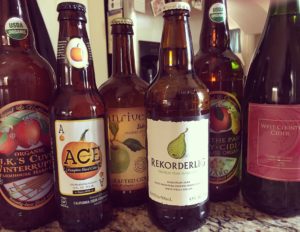Episode 133: Cider Insider
This week we’re exploring cider, its history, how it’s made, styles, and varieties. There’s so much more to this alcoholic beverage than we ever imagined. Val has five glasses in front of her, and Steph discovers “Dances with Squirrels.” Also on deck: our monthly Patreon winner, the next #W25BookClub title, and shoutouts galore. (Recorded 19 October 2017)
Hello curious wine lovers and students of fermented drink! We have several glasses full of information and announcements this week.
In Our Glasses
Steph: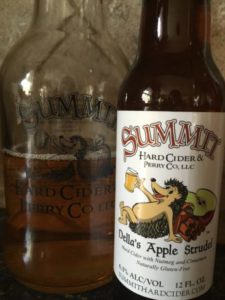
“Yesterday after getting my new hair-do, I walked from the Cutlery Hair Salon to Scrumpy’s Hard Cider Bar and Pub to taste some Summit Cider samples and find something fun for today’s show. I bellied-up to the bar to inquire about growlers, seasonal selections, and anything else I should know about. It was a struggle trying to decide between all the creative flavor combinations such as Strawberry Basil cider, Brumpy’s oak-aged cider, Rasbenero, or Dances with Squirrels. However, I came home with a growler full of the Summit Dry, a champagne-style, classic cider and a 6 pack of bottles of Summit Della’s Apple Strudel.”
Val:
West County, Cidre de Garde, Colrain, MA, 6.3% ABV. They have been making cider since 1984 and are paying homage to farmhouse style ciders of France and Basque Spain. They specifically use heirloom cider apples from their orchards.
JK’s The Pair, Perry Farmhouse Organic Hard Cider, Almar Orchards, Flushing, MI, 5.5% ABV. It’s unfiltered, and a collaboration with Garthe Farms, containing nothing but pear and apple juice, and yeast. They also make an Organic Winterruption Cuvée that was recommended, but we’ve not opened that one yet.
Rekorderlig Premium Pear Hard Cider, Sweden, 4.5% ABV. They recommend serving this one over ice, and it has nutrition information on the back, and a lot of ingredients, including color. I have to be honest in that I was looking for cider beverages that didn’t have artificial “stuff” and additives, but it came on a recommendation.
California Cider Company, Ace, California Pumpkin Hard Cider, Sonoma County, CA, 5% ABV. This is obviously a seasonal, contains additives and flavors, spices. But is also a combination of carbonated water and fermented juice.
https://www.instagram.com/p/BauH0HwD9gj/?hl=en&taken-by=vinowithval
The Cider Insider
History
To learn a little bit about the history of cider, we turn to the National Apple Museum, in Biglerville, PA. Yes, there’s a National Apple Museum.
Like many alcoholic beverages, we can thank the Romans for the proliferation of the beverage. Although they didn’t discover cider, they were certainly fans of it when they stumbled, perhaps literally, across it in England around 55 BC.
Europe had an established cider culture, and in the 9th century there is evidence that apple orchards were intentionally planted to support the beverage’s popularity. And again, like other alcoholic beverages such as wine and beer, the monks got in on the action in the medieval era.
In America, however, we have the English to thank for bringing their apple seeds and know how to our fair colony. Grains, as well as vitis vinifera grapes, were not growing well in American soil, so it was the apple trees that supplied early settlers with a good amount of fermented fun.
It’s important to note that in the US it’s called “hard cider,” because we have a non-alcoholic version we call cider. In England, you may want to look at the ABV (alcohol by volume) before ordering cider for your children.
Over the years, both abroad and here in the US, cider’s popularity rose and fell from the 17th century on. However, today it’s making a comeback, and some would say in large part due to the craft beverage movement. It’s a cider renaissance, people, and we’re on board.
More info on cider history: https://www.smithsonianmag.com/smart-news/ancient-origins-apple-cider-180960662/
How it’s made
Like the production of other beverages, technology and know how has impacted how cider has been produced over hundreds of years. “Back in the day” the apples were hand harvested or beat from the trees with a wooden stick and left in a “tump” and covered with hay for a few weeks.
Once the fruit would dry out, sugars would concentrate. This meant it was time to be milled. Early attempts at milling were manual labor endeavors employing a mortar and pestle or some form of trough. Then along came the mechanical and stone mills. There’s a little more involved in this process, but we’ll link up the National Apple Museum’s page on this if you want to geek out on pulp, “cheese” (not the kind of cheese you’re thinking of), and horsehair (yes, the kind of horsehair you’re thinking of).
After milling, the juice is fermented. Old Hill Cider produced this video that puts the process in perspective.
We should also mention that there are more varieties of apples that end up in classic cider (and Calvados, which is made from apples, and is essentially a cider distilled into brandy) than you’ve seen in the grocery store. They are categorized as bittersweet, bittersharp, sharp, and sweet, with each one bringing something special to the balance party in terms of acids, tannins, and sugars. Many of these are apples you don’t really want to eat. More information than we can jam into this show is available on ciderschool.com.
Types and Styles of Cider/Cidre/Sidra/Hard Cider
While there are many types of apples that can be used to produce ciders, pears are also used. Perry pears, in fact, can be used in Calvados as well. So when you see “Perry cider”, chances are it’s made with both apple and pear juice.
There are also different styles, such as sparkling, still, and even a “port style” cider that Foggy Ridge makes (which we’ve been unsuccessful in getting our mitts on).
Steph mentioned “scrumpy” which is a style that doesn’t use commercial yeast or any other additives.
French styles (known as cidre) tend to have lower ABVs, while Farmhouse styles can be up near the ABV level of wine and soar to 12%. Note that if it’s over 12%, it is then considered an apple wine.
Sidra – Spanish style cider, normally funky, musty, tart, and made with natural yeasts, no sugars added, usually still as opposed to sparkling.
For the Cider Curious
Learn more: Ciderschool.com & cidersage.com are ridiculously comprehensive and resource-intensive sites assembled by Colorado’s own Dan Daugherty, also of St. Vrain Cidery. (@Cidersage on twitter).
Factoid
How to store cider: For short-term, immediate gratification, buy it, keep it in the fridge and drink it.
If you have a growler, and you haven’t poured any out, it will keep for a week or so. Once you start serving out of the growler, you’ve got a few days (1-4) of enjoyable drinking.
Actually, at Scrumpy’s Tap House, the bartender said it lasts a couple of days longer than a growler of beer (36 hours) and still tastes good after it loses its carbonation (unlike beer).
For long-term patience and restraint, store your cider like wine – in a cool, dark place. Depending on the cider and its alcohol content, cider can be stored six months to two years, maybe even longer.
You could actually ballpark-it and store AND serve your cider around 50 degrees. Maybe you like it a little cooler to drink and a little warmer to store, but that’s more-or-less the target.
#W25BookClub
Our next book is a recommendation from Patron and friend Cathey Love in Tennessee. It is the autobiography A Glass Full of Miracles by Mike Grgich.
We love this suggestion Cathey posted on our Facebook community page because of two reasons: Mike’s daughter, Violet Grgich, was a guest on this podcast a year ago in Episode 79; and 2017 marks Grgich Hill’s 40th anniversary.
Also, with regard to the devastating California wildfires, Grgich Hills is safe and open for business.
Reminders:
- Please use the #W25BookClub on social media!
- You can easily order the book right here.
- The Book Review Episode will air on December 21st
*California Wildfire Information*
Recovery efforts are ongoing in California after the devastating wildfires. Here is a comprehensive list of not only these organizations, but ways you can help. As of this posting, this website was just updated on 25 October, 2017: http://www.californiavolunteers.org/index.php/Disaster_Volunteering/current_disasters/
Wine Blogger’s Conference in Santa Rose #WBC17
The Wine Two Five Podcast will be representin’ this year at the Wine Blogger’s Conference: https://winebloggersconference.org/about/ November 9-12, 2017 in Santa Rosa. Please come and say hi!
Shoutouts
Steph: “I have some local peeps and businesses to give shoutouts to – Chef Justin Miner at Hearth Restaurant & Pub, Jim at Locality Kitchen & Bar, our friends Bill & Margie, and our neighbors Mark & Viv!
“And a shoutout to the greater wine world goes to Eric Asimov and his recent article in the New York Times for writing Five Common Wine Myths, Debunked. I especially liked what he said about serving temperatures for wine as well as vintage fixations. Eric was our guest on the podcast back in Episode 72.”
#W25Challenge update
Wine, cider, and … “we don’t think you’re ready for this jelly ’cause #W25Challenge is cider-licious bay-bee.” (Sorry, had to do it.)
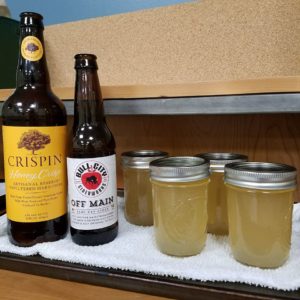
Ash Lombardo, October 19 · FB
Hard cider jelly made with two craft ciders, one from NC. — at Whole Foods Market. Hard Cider jelly recipe: http://www.pomonapectin.com/recipes/apple-rosemary-jelly/
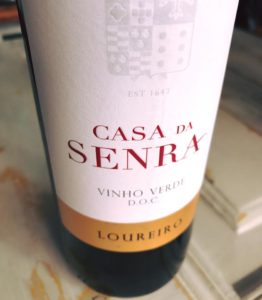
Lynn Gowdy – Wine Two Five Community – October 23 · FB
#W25Challenge From the northern Vinho Verde region of Portugal where it apparently loves the wetter conditions, the Loureiro grape, this one 100%, aromatic- fruity, floral, dried herbs, and refreshing.
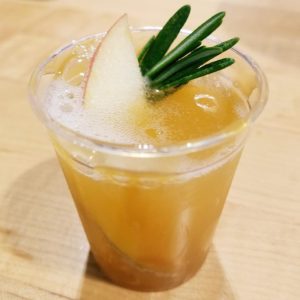
Ash Lombardo – Wine Two Five Community – October 22 · FB
#w25challenge Apple Cider Mimosa. Brut cava, local apple cider, apple slice, rosemary garnish, salted caramel rim.
#Godello grape from #riberadelduoro is a first for me! #w25challenge… https://t.co/cy7pUVx2Ug
— Side Hustle Wino (@SideHustleWino) October 17, 2017
Patreon Love
Thank you to our Patrons who support us on our Patreon crowdfunding platform. Shoutouts and big love to:
“TENacious Tasters”
- Jeff E from the We Like Drinking podcast
- Lynn from Savor the Harvest blog
- Sebastian of Sassi Italy Tours
- Jen in Maryland (and the world, according to her Instagram feed)
- David and Lisa in Illinois
“It’s not five o’clock and we don’t care” Listeners
- Clay in Arizona
- Jon in California
- Andrew in California
- Aswani in California
- Chris and Janet in Colorado
- Diane in Colorado
- Cathie in Georgia
- Steve in Illinois
- Renee in Illinois
- Ashley in North Carolina
- Chantel in Ontario, Canada
- Mary Lou in Pennsylvania
- Meg in South Dakota
- Cathey in Tennessee
Tastemaker Listeners”
- David in Scotland
- Carole in Kentucky
- Karen in California *Welcome!*
“Winetastic Listeners”
- Laura
Go to our Patreon page for details www.patreon.com/winetwofivepodcast on how to be entered into our monthly drawing, exclusive content, and swag.
Connect
We are here for you every week… and in between episodes, you can find us on the social spaces @WineTwoFive and we encourage you to join our private FaceBook group called Wine Two Five Community!
Connect with Val on Twitter @WineGalUnboxed and as Vino With Val on Facebook, Instagram & Pinterest.
Connect with Steph on Twitter, Pinterest and Instagram as TheWineHeroine.
